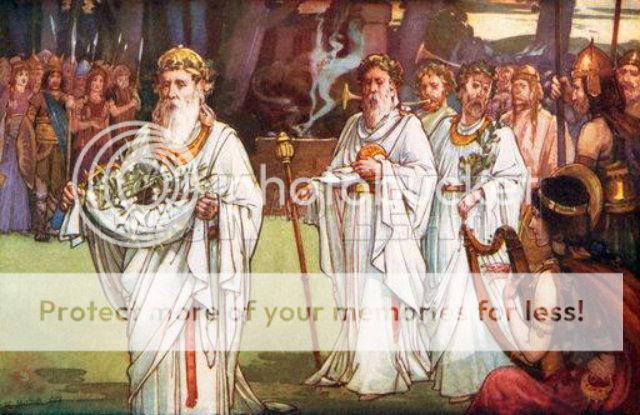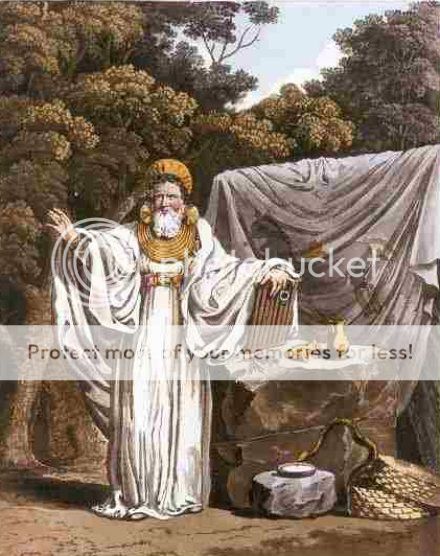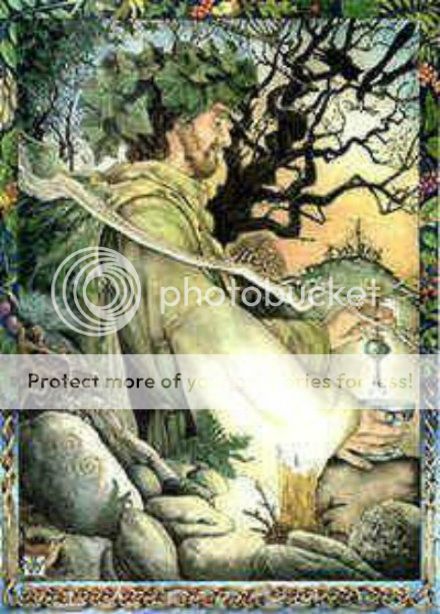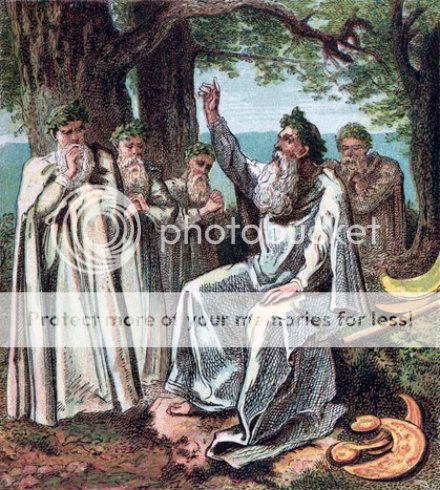-
Sylvhia.
User deleted
The Druids

Druids were members of the educated, professional class among the Celtic peoples of Gaul, Britain, Galicia, Ireland, and possibly elsewhere during the Iron Age. While the best known among the druids were the religious leaders, the druid class also included law-speakers, poets and doctors, among other learned professions. Very little is known about the ancient druids.
They left no written accounts of themselves, and the only evidence is a few descriptions left by Greek, Roman, and various scattered authors and artists, as well as stories created by later medieval Irish writers. While archaeological evidence has been uncovered pertaining to the religious practices of the Iron Age people, "not one single artefact or image has been unearthed that can undoubtedly be connected with the ancient Druids."
Various recurring themes emerge in a number of the Greco-Roman accounts of the druids, including that they performed animal and even human sacrifice, believed in a form of reincarnation, and held a high position in Gaulish society. Next to nothing is known for certain about their cultic practice, except for the ritual of oak and mistletoe as described by Pliny the Elder.
The earliest known reference to the druids dates to 200 BCE, although the oldest actual description comes from the Roman military general Julius Caesar in his Commentarii de Bello Gallico (50s BCE). Following the Roman invasion of Gaul, druidism was suppressed by the Roman government under the 1st century CE emperors Tiberius and Claudius, and it had disappeared from the written record by the 2nd century.
The ritual of oak and mistletoe is described by Pliny the Elder, writing in the 1st century AD, as a religious ceremony in Gaul:
“ The druids – that is what they call their magicians – hold nothing more sacred than the mistletoe and a tree on which it is growing, provided it is Valonia Oak.... Mistletoe is rare and when found it is gathered with great ceremony, and particularly on the sixth day of the moon....Hailing the moon in a native word that means 'healing all things,' they prepare a ritual sacrifice and banquet beneath a tree and bring up two white bulls, whose horns are bound for the first time on this occasion. A priest arrayed in white vestments climbs the tree and, with a golden sickle, cuts down the mistletoe, which is caught in a white cloak. Then finally they kill the victims, praying to a god to render his gift propitious to those on whom he has bestowed it. They believe that mistletoe given in drink will impart fertility to any animal that is barren and that it is an antidote to all poisons.
Pliny was primarily interested in natural history and some scholars have dismissed the testimony in relation to the druids’ ceremony as largely fanciful, particularly as he is the only classical author to mention this ceremony. Yet Pliny specifically associates druids with oak trees. Oaks were held sacred by both druids and Celts alike.
Drunemeton, the ‘oak sanctuary,’ is described by Strabo as a place where the Galatian Council met and oak was used to construct the great Iron Age multi-ring timber structure at Navan Fort in County Armagh.
The Poole Logboat, an ancient logboat made from a single oak tree, and the Corlea Trackway, a simple raised wooden walkway used as the shortest route between two places in a bog or peatland , erano were both made of oak in the Iron Age.
Central to Pliny’s statement is the sanctity of the mistletoe, both as a healing agent and as an aid to fertility. Both these concerns are emphasised in Celtic religious expression. Mistletoe has been reported by archaeologists as having been thought beneficial to sufferers of insomnia, and conditions attributable as high blood pressure and malignancies.
Moreover, that mistletoe may have possessed important symbolism for the Celts is suggested by its presence as a motif in early Celtic art. Human heads bearing curious leaf-shaped crowns are common decorative themes on both jewellery and stone monuments.
The lobed shape of the leaves on these objects closely resembles the leaves of European mistletoe and, if such an identification be correct, it may be that the faces depicted in this pre-Roman art are those of priests or gods.
In Pliny’s comments, three other points of significance concern banqueting, the moon and bull-sacrifice. All three are familiar to the repertoire of Celtic religion. Ritual banquets are represented in some rich tombs of both the early and late Iron Age of Celtic Europe: the Hallstatt chieftain’s tomb at Hochdorf was furnished with a set of nine drinking horns and a nine-piece dinner service, for the otherworld Banquet, as well as a huge cauldron of mead.
Certain shrines exhibit abundant evidence of ceremonial banquets: excavators of the sanctuary at Mirebeau, in northern France, found a veritable carpet of bones from butchered animals and broken pots, which appear to be the remains of feasting.
Pliny makes allusions to the moon on its sixth day, a waxing crescent moon, as an instrument of healing: here again there is corroborative evidence in that Celtic goddesses associated with healing and regeneration are sometimes depicted wearing lunar amulets; and the great temple of the healer-goddess Sulis Minerva at Bath, Somerset bears a carving of the Roman moon-goddess Luna. Among the finds at Bath, Somerset was a lunar pendant, possibly once part of a priest’s sceptre.
Lastly, bull-sacrifice is attested in other evidence. Cattle were commonly used as sacrificial animals: the shrine of Gournay in Picardy was the scene of repeated ox-sacrifice and cattle were ritually slaughtered in numerous Celtic sanctuaries.
Bull-sacrifice is twice depicted on the Gundestrup cauldron and was probably made in the 1st century BC. In Irish mythology, the Tarbhfhess, the ‘bull-sleep,’ was a ritual closely associated with druids: a selected individual was fed on bull flesh before being chanted to sleep by four druids; while he slept he dreamt of the next rightful High King of Ireland and when he awoke he gave this information to his druid attendants.
http://en.wikipedia.org/wiki/Druid
http://en.wikipedia.org/wiki/Ritual_of_oak_and_mistletoe.
The Druids02 Agosto 2014 |


